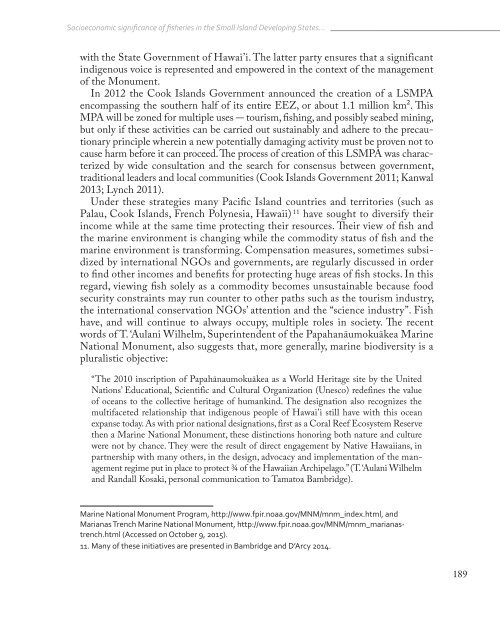Fisheries in the Pacific
Fisheries_in_the_Pacific
Fisheries_in_the_Pacific
Create successful ePaper yourself
Turn your PDF publications into a flip-book with our unique Google optimized e-Paper software.
Socioeconomic significance of fisheries <strong>in</strong> <strong>the</strong> Small Island Develop<strong>in</strong>g States…<br />
with <strong>the</strong> State Government of Hawai’i. The latter party ensures that a significant<br />
<strong>in</strong>digenous voice is represented and empowered <strong>in</strong> <strong>the</strong> context of <strong>the</strong> management<br />
of <strong>the</strong> Monument.<br />
In 2012 <strong>the</strong> Cook Islands Government announced <strong>the</strong> creation of a LSMPA<br />
encompass<strong>in</strong>g <strong>the</strong> sou<strong>the</strong>rn half of its entire EEZ, or about 1.1 million km². This<br />
MPA will be zoned for multiple uses tourism, fish<strong>in</strong>g, and possibly seabed m<strong>in</strong><strong>in</strong>g,<br />
but only if <strong>the</strong>se activities can be carried out susta<strong>in</strong>ably and adhere to <strong>the</strong> precautionary<br />
pr<strong>in</strong>ciple where<strong>in</strong> a new potentially damag<strong>in</strong>g activity must be proven not to<br />
cause harm before it can proceed. The process of creation of this LSMPA was characterized<br />
by wide consultation and <strong>the</strong> search for consensus between government,<br />
traditional leaders and local communities (Cook Islands Government 2011; Kanwal<br />
2013; Lynch 2011).<br />
Under <strong>the</strong>se strategies many <strong>Pacific</strong> Island countries and territories (such as<br />
Palau, Cook Islands, French Polynesia, Hawaii) 11 have sought to diversify <strong>the</strong>ir<br />
<strong>in</strong>come while at <strong>the</strong> same time protect<strong>in</strong>g <strong>the</strong>ir resources. Their view of fish and<br />
<strong>the</strong> mar<strong>in</strong>e environment is chang<strong>in</strong>g while <strong>the</strong> commodity status of fish and <strong>the</strong><br />
mar<strong>in</strong>e environment is transform<strong>in</strong>g. Compensation measures, sometimes subsidized<br />
by <strong>in</strong>ternational NGOs and governments, are regularly discussed <strong>in</strong> order<br />
to f<strong>in</strong>d o<strong>the</strong>r <strong>in</strong>comes and benefits for protect<strong>in</strong>g huge areas of fish stocks. In this<br />
regard, view<strong>in</strong>g fish solely as a commodity becomes unsusta<strong>in</strong>able because food<br />
security constra<strong>in</strong>ts may run counter to o<strong>the</strong>r paths such as <strong>the</strong> tourism <strong>in</strong>dustry,<br />
<strong>the</strong> <strong>in</strong>ternational conservation NGOs’ attention and <strong>the</strong> “science <strong>in</strong>dustry”. Fish<br />
have, and will cont<strong>in</strong>ue to always occupy, multiple roles <strong>in</strong> society. The recent<br />
words of T. ‘Aulani Wilhelm, Super<strong>in</strong>tendent of <strong>the</strong> Papahanāumokuākea Mar<strong>in</strong>e<br />
National Monument, also suggests that, more generally, mar<strong>in</strong>e biodiversity is a<br />
pluralistic objective:<br />
“The 2010 <strong>in</strong>scription of Papahānaumokuākea as a World Heritage site by <strong>the</strong> United<br />
Nations’ Educational, Scientific and Cultural Organization (Unesco) redef<strong>in</strong>es <strong>the</strong> value<br />
of oceans to <strong>the</strong> collective heritage of humank<strong>in</strong>d. The designation also recognizes <strong>the</strong><br />
multifaceted relationship that <strong>in</strong>digenous people of Hawai’i still have with this ocean<br />
expanse today. As with prior national designations, first as a Coral Reef Ecosystem Reserve<br />
<strong>the</strong>n a Mar<strong>in</strong>e National Monument, <strong>the</strong>se dist<strong>in</strong>ctions honor<strong>in</strong>g both nature and culture<br />
were not by chance. They were <strong>the</strong> result of direct engagement by Native Hawaiians, <strong>in</strong><br />
partnership with many o<strong>the</strong>rs, <strong>in</strong> <strong>the</strong> design, advocacy and implementation of <strong>the</strong> management<br />
regime put <strong>in</strong> place to protect ¾ of <strong>the</strong> Hawaiian Archipelago.” (T. ‘Aulani Wilhelm<br />
and Randall Kosaki, personal communication to Tamatoa Bambridge).<br />
Mar<strong>in</strong>e National Monument Program, http://www.fpir.noaa.gov/MNM/mnm_<strong>in</strong>dex.html, and<br />
Marianas Trench Mar<strong>in</strong>e National Monument, http://www.fpir.noaa.gov/MNM/mnm_marianastrench.html<br />
(Accessed on October 9, 2015).<br />
11. Many of <strong>the</strong>se <strong>in</strong>itiatives are presented <strong>in</strong> Bambridge and D’Arcy 2014.<br />
189


